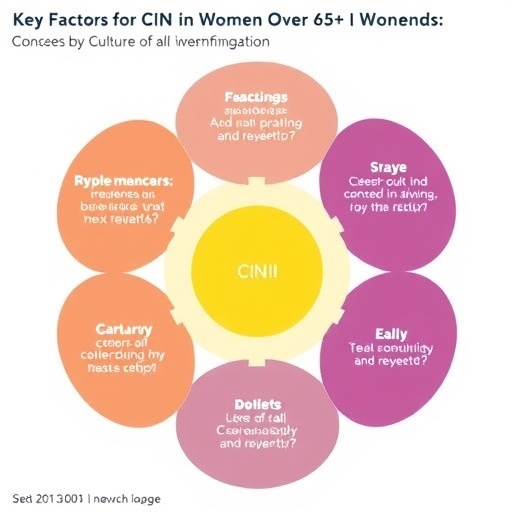In the realm of women’s healthcare, understanding the complexities of cervical intraepithelial neoplasia (CIN) is crucial, particularly among older women. A recent study conducted by Sahin, Ulu, and Yuksel brings attention to the predictive determinants of CIN II+ lesions specifically in women over 65 years old. This demographic faces unique challenges regarding cervical health, often compounded by hormonal changes and lifestyle factors. The researchers delve into the role of human papillomavirus (HPV) and advanced diagnostic techniques, such as colposcopy and double immunostaining, in forecasting these potentially precancerous conditions.
Cervical intraepithelial neoplasia is a key indicator of cervical cancer risk, categorized into grades based on severity. CIN I represents mild dysplasia, while CIN II and III denote more severe forms. The identification of factors leading to CIN II+ lesions is vital in stratifying risk and guiding preventive measures. This study is particularly significant given that the age group analyzed has been historically overlooked in cervical cancer prevention strategies. As women age, the manifestation of HPV-related lesions can become more complicated, necessitating a focused investigation.
The researchers emphasized the importance of HPV as a primary etiological factor in cervical cancer. HPV is a sexually transmitted infection, with certain strains known to be high-risk for cervical cancer. Most women will clear the virus naturally; however, a persistent infection can lead to progressive cervical changes. Understanding the relationship between HPV infections and the incidence of CIN II+ lesions in older populations can help develop targeted screening protocols and vaccination initiatives.
Colposcopy, a diagnostic procedure allowing for the detailed examination of the cervix, plays a pivotal role in the management of CIN. The study highlights that traditional cytology may not adequately predict the presence of CIN II+ lesions, particularly in older women. Colposcopy enables clinicians to visualize abnormal areas, guiding biopsy and treatment decisions more effectively. This technique, however, requires skilled practitioners to ensure accurate assessments and improve patient outcomes.
Double immunostaining is another innovative approach that the study explores. This technique involves using antibodies to detect different cellular markers simultaneously, enhancing the ability to identify abnormal cell populations. By applying double immunostaining, clinicians can gain nuanced insights into tumor biology and the associated risk factors for CIN II+ lesions. This advanced technique promises to refine our understanding of cervical pathology and personalized patient care, especially in the context of aging.
Moreover, the research aims to compile a more comprehensive understanding of risk factors contributing to CIN II+ lesions in older women. Beyond HPV, the study indicates that menopausal status, smoking history, and socio-economic factors significantly influence cervical health. Addressing these broader determinants can help healthcare providers devise more effective screening and prevention strategies that account for the unique circumstances surrounding older women.
Interestingly, the psychosocial dimensions of undergoing screenings like pap smears and colposcopies are equally important to consider. Many older women may feel hesitant to participate in screenings or discuss their sexual health needs, driven by stigma or misinformation. As healthcare practitioners, it becomes imperative to foster an environment of open communication and education, ensuring that every woman recognizes the importance of cervical health, regardless of age.
The adaptation of screening protocols to better suit the older demographic is another focal point of the research findings. Current guidelines may not cater adequately to the complexities faced by older women, who might experience different health trajectories and responses to HPV. This highlights the need for a paradigm shift in how cervical health screenings are approached, focusing on individualized assessments and tailored interventions.
The implications of this study are far-reaching. By elucidating the predictive determinants of CIN II+ lesions, naluding HPV prevalence, clinicians can enhance decision-making processes in cervical cancer prevention. In addition, the integration of advanced diagnostic techniques can lead to more accurate early detections of lesions that require intervention, ultimately reducing the incidence of cervical cancer in older women.
The researchers advocate for further studies to validate and build upon their findings, suggesting a multi-center approach to enhance the reliability of the results. These insights could facilitate the development of national guidelines addressing cervical cancer prevention that specifically target the needs of older women. Comprehensive strategies that incorporate education, screening, and follow-up care can significantly impact public health outcomes.
In conclusion, the research conducted by Sahin, Ulu, and Yuksel underscores the urgent need to address the cervical health of women over 65 years old with a comprehensive understanding of predictive determinants. The role of HPV, colposcopy, and double immunostaining are central to this effort, promising to refine the approach to screening and treatment for older women. As our understanding of cervical cancer evolves, so too must our strategies to empower and protect all women, regardless of age.
This study serves as a catalyst for change in cervical cancer prevention policies, ensuring that older women receive the targeted care they deserve. As we continue to navigate the complexities of women’s health, it is essential to remain proactive in confronting the challenges that threaten this vulnerable population. With ongoing research and advocacy, we can work towards a future where cervical cancer is no longer a reality for older women.
Subject of Research: Predictive determinants of CIN II+ lesions in women over 65 years old
Article Title: Predictive determinants of CIN II + lesions in women over 65 years old: the contribution of HPV, colposcopy, and double immunostaining techniques.
Article References:
Sahin, G., Ulu, F.Y. & Yuksel, I.T. Predictive determinants of CIN II + lesions in women over 65 years old: the contribution of HPV, colposcopy, and double immunostaining techniques.
BMC Geriatr 25, 855 (2025). https://doi.org/10.1186/s12877-025-06524-1
Image Credits: AI Generated
DOI: https://doi.org/10.1186/s12877-025-06524-1
Keywords: HPV, CIN II+, older women, colposcopy, double immunostaining, women’s health, cervical cancer, predictive determinants.
Tags: addressing cervical health disparitiesadvanced diagnostic techniques for cervical healthcervical intraepithelial neoplasia in older womenCIN II+ risk factors for women over 65HPV and cervical cancer in elderly womenimpact of hormonal changes on cervical lesionsimportance of HPV vaccination in elderly populationslifestyle factors influencing CIN in older womenpreventive measures for cervical cancer in older womensignificance of colposcopy in detecting CINstrategies for cervical cancer screening in seniorsunderstanding cervical dysplasia grades





